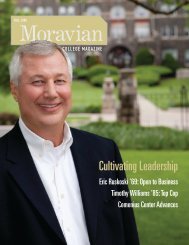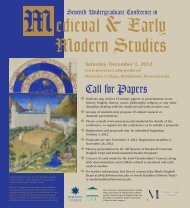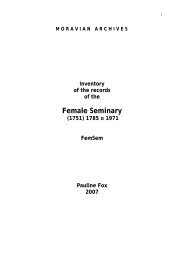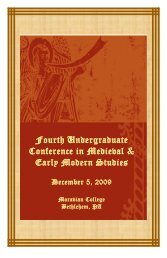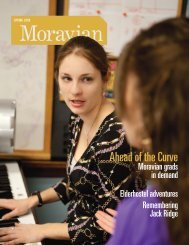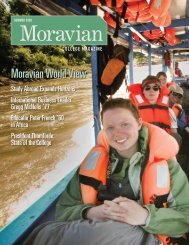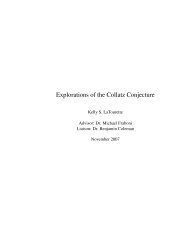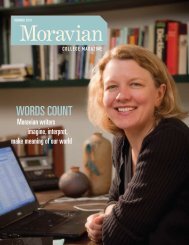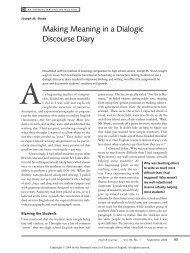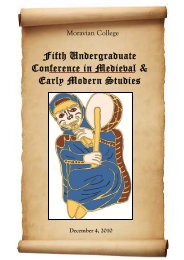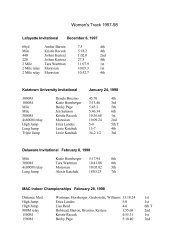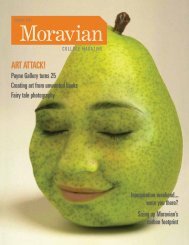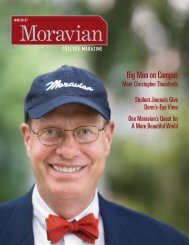MORAVIAN VISION - Moravian College
MORAVIAN VISION - Moravian College
MORAVIAN VISION - Moravian College
Create successful ePaper yourself
Turn your PDF publications into a flip-book with our unique Google optimized e-Paper software.
The First Fruits (above), oil on canvas by<br />
Johann Valentin Haidt, ca. 1760, depicts a group<br />
of <strong>Moravian</strong> converts from different nations<br />
gathered as "the first fruits" (Rev. 14:4) around<br />
the throne of Christ. To view other historical<br />
<strong>Moravian</strong> paintings, visit the <strong>Moravian</strong> Archives<br />
(www.moravianchurcharchives.org), the official<br />
repository for records of the <strong>Moravian</strong> Church<br />
in America. Located in Bethlehem, the Archives<br />
hold thousands of pamphlets, paintings, prints,<br />
maps, photographs, and personal papers.<br />
Defining <strong>Moravian</strong><br />
In October, history and music scholars from<br />
around the world met at <strong>Moravian</strong> <strong>College</strong>’s<br />
Priscilla Payne Hurd Campus and the <strong>Moravian</strong><br />
Church’s Gemeinhaus (Bethlehem’s oldest<br />
building) for the Biennial Conference on <strong>Moravian</strong><br />
History and Culture and Annual Conference<br />
on <strong>Moravian</strong> Music.<br />
The history and culture<br />
lectures explored <strong>Moravian</strong><br />
contributions, underscoring<br />
their geographic and<br />
social importance. “We are<br />
seeing the past as it was<br />
and making a claim on our<br />
February 18<br />
Québécité<br />
������������������������������������������<br />
��������������������������������������������<br />
��������������������������������������������������<br />
�����������������������������������������������<br />
����������������������������<br />
historical heritage,” commented Heikki<br />
Lempa, chair and assistant professor of history,<br />
who helped organize the History and<br />
Culture Conference. Topics included rituals<br />
and practices, historical self-concepts, and<br />
encounters with foreign worlds.<br />
In the lecture “<strong>Moravian</strong> Missions in the<br />
Nicaraguan Mosquitia from 1894 to 1936,”<br />
presenter Edwin Taylor, of the University of<br />
the Autonomous Regions of the Caribbean<br />
Coast of Nicaragua, recounted the experiences<br />
of early twentieth-century <strong>Moravian</strong>s<br />
working in the coastal towns of Nicaragua.<br />
The <strong>Moravian</strong>s left thorough written<br />
records, providing historians with valuable<br />
details about people, places, and events.<br />
Rowena McClinton, of Southern Illinois University,<br />
presented an analysis of <strong>Moravian</strong><br />
missionary Anna Rosina Gambold’s written<br />
accounts, which revealed a peaceful coexistence<br />
with the Cherokee tribe.<br />
Paul Peucker, director of the <strong>Moravian</strong><br />
Archives, presented the Walter Vivian<br />
Moses Lecture, “Beyond Beeswax Candles<br />
<br />
and Lovefeast Buns: The Role of History in<br />
Finding a <strong>Moravian</strong> Identity,” arguing that<br />
<strong>Moravian</strong>s created a common identity by<br />
consciously constructing a common history.<br />
Highlights of the <strong>Moravian</strong> Music Conference<br />
included presentations on noted musicians<br />
and composers, such as Conrad Beissel<br />
and C. I. Latrobe; early instruments, including<br />
the cittern, serpent, and <strong>Moravian</strong> bass<br />
horn; and historical <strong>Moravian</strong> hymnal music.<br />
A concert of <strong>Moravian</strong> music, featuring the<br />
choirs of <strong>Moravian</strong> <strong>College</strong> and Central <strong>Moravian</strong><br />
Church, concluded the music conference.<br />
— By Meghan Decker<br />
FALL 2008 <strong>MORAVIAN</strong> COLLEGE MAGAZINE 5



